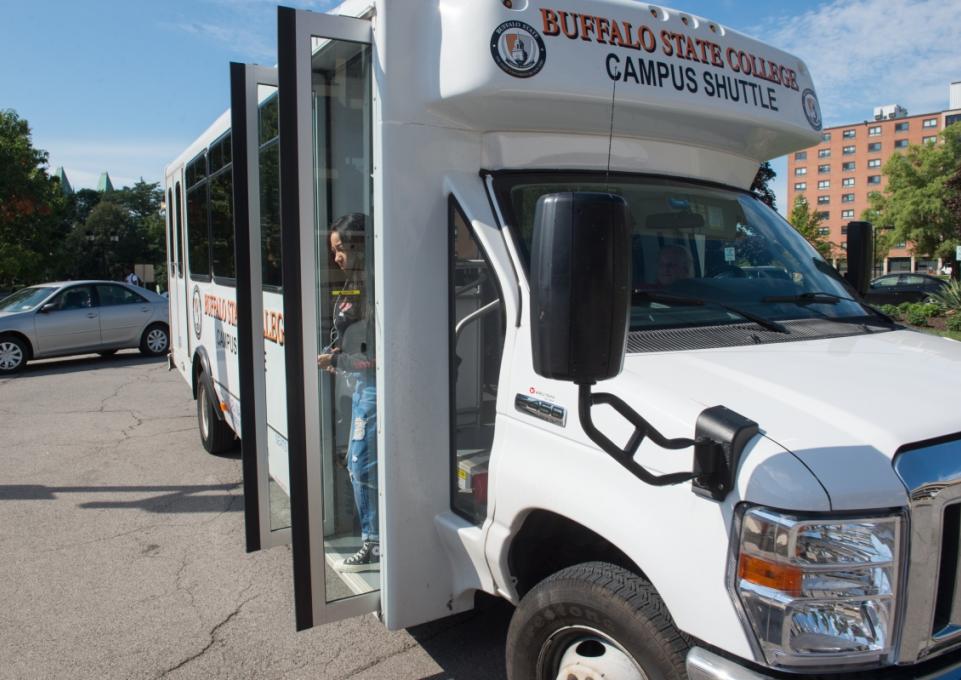
The campus shuttle service’s new minibus brought an immediate and dramatic increase in ridership within its first year.
According to statistics provided by the University Police Department, the combined number of passengers during the 2018–2019 school year reflects a fivefold increase over last, with more than 40,000 passengers now using the service.
“Those numbers speak for themselves,” said Lisa H. Krieger, associate vice president for administrative services. “The students see the accessible vehicle clearly marked with the college name, and they’re getting on board.”
Now in its ninth year of operation, the campus shuttle began as a van service, operated by university police student assistants, to provide convenient and safe transportation for everyone on campus. This improved minibus, which can carry up to 15 passengers per trip, was implemented in August 2018 as an enhancement to Buffalo State’s Safe Escort Programs.
“I think the biggest impact is that we’ve dramatically increased ridership,” said UPD Chief of Police Peter M. Carey, “so that obviously increases safety, because if someone is on the bus with other people and the driver, they’re not walking alone.”
Krieger and the Parking Services Office are the leads on the shuttle service project. She said the ridership numbers serve as validation to the resources that have been committed for operating the bus.
“I’m so gratified that it’s getting so much use,” she said. “I think that’s the reward right there, that students are taking advantage, and faculty and staff, and it’s accessible.”
The shuttle operates along three routes (PDF, 3.8 MB): the daytime Grant-Cleveland shuttle; the evening shuttle, which travels to all lots and most buildings; and, added last year, a Tops/Wegmans shuttle that runs weeknights and weekends.
Both the SmartTraxx app (for Android and iPhone) and the Safe Escort Programs web page provide information regarding shuttle routes, times and days of operation, and even a live tracker of the shuttle’s current location, which allows passengers to gauge their wait times.
There is also a map of Blue Light Phones (PDF, 4.8 MB) that shows which ones are designated as shuttle stops.
“I’m very supportive and happy to see that this has been such a positive impact on the campus and in particular, our students,” said Laura Barnum, vice president for finance and management. “This really has been a critical change, and the students have really received it well.”
Carey credits the new shuttle’s design with creating a more enjoyable riding experience, with wider aisles and a more rider-friendly seating design, which improves comfort and promotes opportunities for socialization among passengers. The bus is fully compliant with the Americans with Disabilities Act.
“The college and our department want to provide accessibility to all services of the campus, including the shuttle service,” Carey said. “In doing that, in order to be wheelchair accessible, you need a larger vehicle.”
While the shuttle service was mainly designed to accommodate students, it is available to anyone visiting the campus.
“We encourage employees to use it, too,” Krieger said. She also advised commuters to park in the Grant Street lot and ride the shuttle to the center of campus as a quicker alternative to searching for a parking space in a crowded lot.
Whether or not they choose to ride the shuttle, Carey advises everyone to practice mindfulness and to take care when traveling to buildings and lots.
“We tell people all the time, stop paying attention to your phone,” he said. “Take your earbuds out of your ears, keep your phone in your pocket or your purse, and walk with a purpose for those few minutes it takes to get where you are going.
“Your safety is infinitely more important than anything that’s on that phone.”
